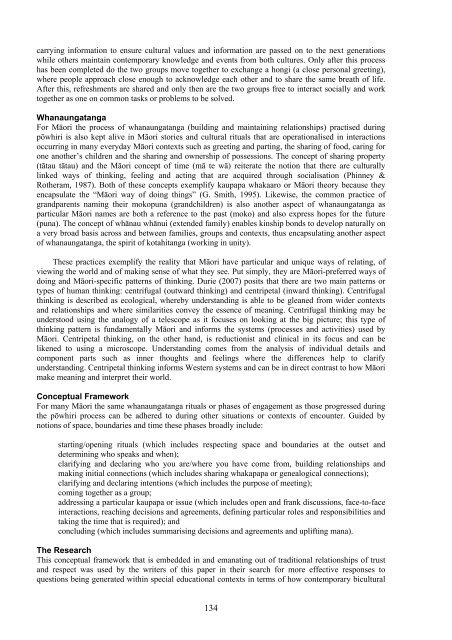traditional knowledge conference 2008 te tatau pounamu
traditional knowledge conference 2008 te tatau pounamu
traditional knowledge conference 2008 te tatau pounamu
You also want an ePaper? Increase the reach of your titles
YUMPU automatically turns print PDFs into web optimized ePapers that Google loves.
carrying information to ensure cultural values and information are passed on to the next generationswhile others maintain con<strong>te</strong>mporary <strong>knowledge</strong> and events from both cultures. Only af<strong>te</strong>r this processhas been comple<strong>te</strong>d do the two groups move together to exchange a hongi (a close personal greeting),where people approach close enough to ac<strong>knowledge</strong> each other and to share the same breath of life.Af<strong>te</strong>r this, refreshments are shared and only then are the two groups free to in<strong>te</strong>ract socially and worktogether as one on common tasks or problems to be solved.WhanaungatangaFor Māori the process of whanaungatanga (building and maintaining relationships) practised duringpōwhiri is also kept alive in Māori stories and cultural rituals that are operationalised in in<strong>te</strong>ractionsoccurring in many everyday Māori con<strong>te</strong>xts such as greeting and parting, the sharing of food, caring forone another’s children and the sharing and ownership of possessions. The concept of sharing property(tātau tātau) and the Māori concept of time (mā <strong>te</strong> wā) rei<strong>te</strong>ra<strong>te</strong> the notion that there are culturallylinked ways of thinking, feeling and acting that are acquired through socialisation (Phinney &Rotheram, 1987). Both of these concepts exemplify kaupapa whakaaro or Māori theory because theyencapsula<strong>te</strong> the “Māori way of doing things” (G. Smith, 1995). Likewise, the common practice ofgrandparents naming their mokopuna (grandchildren) is also another aspect of whanaungatanga asparticular Māori names are both a reference to the past (moko) and also express hopes for the future(puna). The concept of whānau whānui (ex<strong>te</strong>nded family) enables kinship bonds to develop naturally ona very broad basis across and between families, groups and con<strong>te</strong>xts, thus encapsulating another aspectof whanaungatanga, the spirit of kotahitanga (working in unity).These practices exemplify the reality that Māori have particular and unique ways of relating, ofviewing the world and of making sense of what they see. Put simply, they are Māori-preferred ways ofdoing and Māori-specific pat<strong>te</strong>rns of thinking. Durie (2007) posits that there are two main pat<strong>te</strong>rns ortypes of human thinking: centrifugal (outward thinking) and centripetal (inward thinking). Centrifugalthinking is described as ecological, whereby understanding is able to be gleaned from wider con<strong>te</strong>xtsand relationships and where similarities convey the essence of meaning. Centrifugal thinking may beunderstood using the analogy of a <strong>te</strong>lescope as it focuses on looking at the big picture; this type ofthinking pat<strong>te</strong>rn is fundamentally Māori and informs the sys<strong>te</strong>ms (processes and activities) used byMāori. Centripetal thinking, on the other hand, is reductionist and clinical in its focus and can belikened to using a microscope. Understanding comes from the analysis of individual details andcomponent parts such as inner thoughts and feelings where the differences help to clarifyunderstanding. Centripetal thinking informs Wes<strong>te</strong>rn sys<strong>te</strong>ms and can be in direct contrast to how Māorimake meaning and in<strong>te</strong>rpret their world.Conceptual FrameworkFor many Māori the same whanaungatanga rituals or phases of engagement as those progressed duringthe pōwhiri process can be adhered to during other situations or con<strong>te</strong>xts of encoun<strong>te</strong>r. Guided bynotions of space, boundaries and time these phases broadly include:starting/opening rituals (which includes respecting space and boundaries at the outset andde<strong>te</strong>rmining who speaks and when);clarifying and declaring who you are/where you have come from, building relationships andmaking initial connections (which includes sharing whakapapa or genealogical connections);clarifying and declaring in<strong>te</strong>ntions (which includes the purpose of meeting);coming together as a group;addressing a particular kaupapa or issue (which includes open and frank discussions, face-to-facein<strong>te</strong>ractions, reaching decisions and agreements, defining particular roles and responsibilities andtaking the time that is required); andconcluding (which includes summarising decisions and agreements and uplifting mana).The ResearchThis conceptual framework that is embedded in and emanating out of <strong>traditional</strong> relationships of trustand respect was used by the wri<strong>te</strong>rs of this paper in their search for more effective responses toquestions being genera<strong>te</strong>d within special educational con<strong>te</strong>xts in <strong>te</strong>rms of how con<strong>te</strong>mporary bicultural134
















